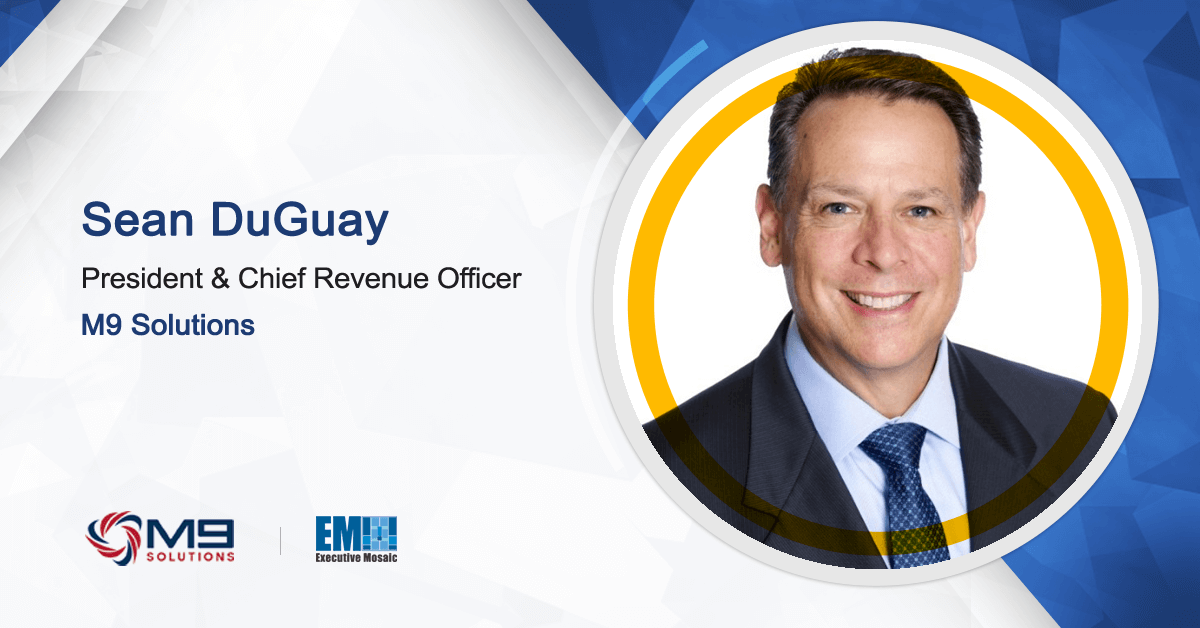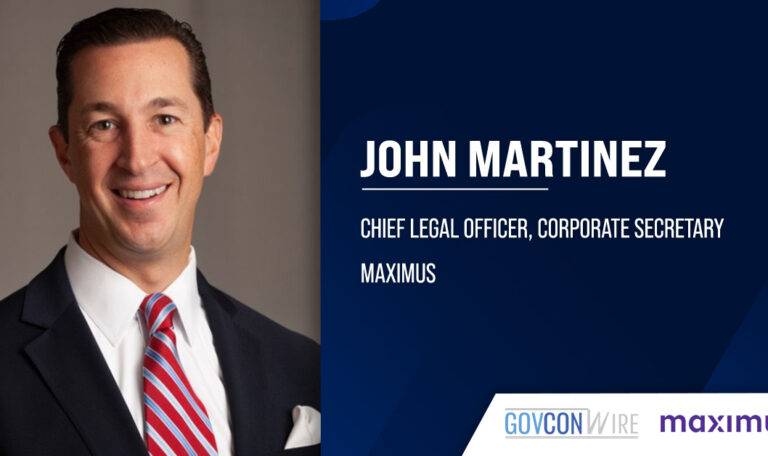Artificial intelligence advancements are catalyzing innovations that ripple across multiple sectors. Particularly in the federal government and government contracting industry, AI is changing the game for the workforce, cybersecurity, cloud, decision making and so much more.
In this Executive Spotlight interview, Executive Mosaic sat down with M9 Solutions President and Chief Revenue Officer Sean DuGuay to discuss what’s next for AI in the GovCon ecosystem and how the technology could impact different facets of the federal landscape.
GovCon Wire: Where do we currently stand in regards to AI technologies and capabilities, and where do you think AI is headed next?
Sean DuGuay: The federal government is taking a proactive and comprehensive approach to AI technologies, aiming to harness their potential while addressing associated risks. I recently attended a conference on this very subject the other day where leaders for DARPA, Army, Air Force and another intelligence agency provided more direction in this area.
The government’s approach includes several key actions and initiatives:
Safety and Security
Following an executive order by President Biden, agencies have developed frameworks to mitigate AI’s risks to safety and security. This includes guidelines for nucleic acid synthesis screening to prevent the misuse of AI in creating dangerous biological materials, and AI safety and security guidelines for critical infrastructure. A very interesting example of the use of AI in the combat theater is that when a combat person is wounded, prior to a medivac showing up, AI has all the information on the wounded, the closest triage center which has that person’s blood type, an available bed, the necessary doctors and a host of other items to ensure the person lives! This is a huge advancement in AI.
Regulatory and Ethical Frameworks
The government has issued draft documents for managing generative AI risks and developed principles for the non-discriminatory use of AI in sectors like housing and employment. These efforts are complemented by initiatives from the National Institute of Standards and Technology, or NIST, to create comprehensive AI risk management frameworks.
AI Talent and Innovation
To foster innovation, the administration has launched initiatives like the AI Talent Surge to hire more AI professionals and the National AI Research Resource pilot to provide resources for AI research. Additionally, the EducateAI initiative aims to create inclusive AI educational opportunities from K-12 to undergraduate levels.
Internal Use and Oversight
Agencies like the Government Accountability Office are exploring internal AI use to enhance efficiency and effectiveness. This includes deploying large language models to assist with report synthesis, editorial reviews and scanning congressional documents.
Promoting Responsible Use
The General Services Administration has provided detailed guides on machine learning techniques and their applications, emphasizing the importance of understanding AI’s limitations and potential misuse (GSA IT Mod CoEs).
The next iterations of AI in government will likely be in the following areas: improved natural language processing, enhanced computer vision, reinforcement learning and adaptive systems, ethical AI and bias mitigation, quantum computing integration and AI in cybersecurity. There are other areas more specific to the commercial world but these are being actively worked on in the federal sector today. All of these areas are being actively discussed and worked on within the government today.
GCW: The foundation of AI is data. What are the challenges and opportunities you’re seeing emerge as agencies harness data and use it to drive decisions?
DuGuay: I attend a lot of data conferences and I speak to many federal chief data officers. I believe most if not all will agree with me on these points.
Key Challenges
- Data Privacy and Security:
- Ensuring the protection of sensitive information against breaches and unauthorized access.
- Complying with federal regulations while managing vast amounts of data.
- Data Integration:
- Combining data from various sources and formats into a unified system can be complex.
- Overcoming silos within agencies to create a cohesive data strategy.
- Data Quality:
- Ensuring the accuracy, completeness, and reliability of data.
- Implementing robust data governance frameworks to maintain data integrity.
- Skills Gap:
- Shortage of data science and analytics talent within government agencies.
- Providing ongoing training and development to keep up with evolving technologies.
- Technological Infrastructure:
- Upgrading legacy systems to support modern data analytics capabilities.
- Ensuring interoperability between new and existing systems.
- Cultural Resistance:
- Overcoming resistance to change within organizations.
- Encouraging a data-driven culture among employees at all levels.
Key Opportunities
- Improved Decision-Making:
- Leveraging data analytics to make more informed and timely decisions.
- Using predictive analytics to anticipate and mitigate potential issues.
- Increased Efficiency:
- Automating routine tasks and processes to save time and resources.
- Optimizing operations through data-driven insights.
- Enhanced Public Services:
- Using data to better understand and respond to citizen needs.
- Personalizing services and improving overall public satisfaction.
- Policy Development:
- Using data to inform and shape public policy more effectively.
- Identifying trends and patterns that can guide policy decisions.
- Transparency and Accountability:
- Increasing transparency by making data accessible to the public.
- Enhancing accountability through data-driven performance monitoring.
- Innovation and Modernization:
- Driving innovation by adopting advanced data analytics and AI technologies.
- Modernizing infrastructure and processes to stay ahead of technological advancements.
GCW: Let’s talk about cloud. What opportunities can be unlocked with the cloud, and how do you think those opportunities will change the federal landscape?
DuGuay:
- Improved Efficiency and Cost Savings:
- Scalability: Cloud services allow federal agencies to scale their IT resources up or down based on demand, reducing waste and optimizing resource use.
- Cost Reduction: By moving to the cloud, agencies can save on hardware, software and maintenance costs, transitioning from capital expenditures to more manageable operational expenses.
- Resource Optimization: Cloud computing enables better utilization of IT resources, eliminating the need for over-provisioning and reducing idle resource costs.
- Enhanced Security and Compliance:
- Security Enhancements: Cloud providers offer advanced security features, including encryption, threat detection and automated compliance, which can enhance the security posture of federal agencies.
- Compliance: Many cloud providers offer services that are compliant with federal regulations such as FedRAMP, making it easier for agencies to meet compliance requirements.
- Improved Collaboration and Productivity:
- Remote Work Enablement: The cloud facilitates remote work by providing secure access to applications and data from any location, enhancing productivity and work flexibility.
- Collaboration Tools: Cloud-based collaboration tools like document sharing, video conferencing and project management platforms improve teamwork and communication within and across agencies.
- Data Management and Analytics:
- Data Storage and Management: The cloud provides virtually unlimited storage capacity, enabling federal agencies to manage and store large volumes of data efficiently.
- Advanced Analytics: Cloud platforms offer powerful analytics tools that can process large datasets, providing insights and enabling data-driven decision-making.
- Artificial Intelligence and Machine Learning: Cloud services support AI and ML applications, which can be used for predictive analytics, automating routine tasks and improving service delivery.
- Innovation and Modernization:
- Agility and Innovation: Cloud platforms support rapid deployment and testing of new applications and services, fostering innovation and modernization of IT systems.
- Application Modernization: Federal agencies can modernize legacy applications by moving them to the cloud, improving performance and extending their lifespan.
Impact on the Federal Landscape
- Operational Transformation: The shift to the cloud will transform federal IT operations, making them more agile, efficient and responsive to changing needs.
- Workforce Evolution: Federal agencies will need to invest in training and upskilling their workforce to manage and leverage cloud technologies effectively.
- Policy and Governance: The adoption of cloud computing will necessitate updates to policies and governance frameworks to address new security, compliance and operational challenges.
- Service Delivery: Enhanced cloud capabilities will enable federal agencies to deliver more efficient and effective services to citizens, improving public satisfaction and trust in government.
Overall, the adoption of cloud computing in the federal landscape will drive significant improvements in efficiency, security and service delivery, positioning federal agencies to better meet the needs of the public in a rapidly evolving digital environment.
GCW: What are some of the top workforce trends you’re seeing right now, and how are they impacting the GovCon market?
DuGuay: I recently spoke at two technology events where this question was asked specifically, and I’ve taken my thoughts and also additional thoughts from both industry and federal government employees who are dealing with these very issues. Several key workforce trends in the technology industry are significantly affecting the federal government and the GovCon industry as a whole:
- Remote Work and Hybrid Models:
- Trend: The shift towards remote and hybrid work models has accelerated and become a norm since the COVID-19 pandemic. People got used to working from home and it’s become an expectation.
- Impact on federal government and GovCon industry: Agencies are adopting flexible work policies to attract and retain top talent. This trend necessitates investments in secure remote access technologies and robust cybersecurity measures.
- Cybersecurity Skills Shortage:
- Trend: There is a fast-growing demand for cybersecurity professionals due to increasing cyber threats.
- Impact on federal government and GovCon industry: Federal agencies face challenges in recruiting and retaining skilled cybersecurity personnel. This shortage impacts the government’s ability to protect sensitive information and critical infrastructure.
- Artificial Intelligence (AI) and Automation:
- Trend: The integration of AI and automation is transforming various sectors, including public services.
- Impact on federal government and GovCon industry: The adoption of AI can enhance efficiency and decision-making in government operations. However, it also requires a workforce skilled in AI technologies and ethical considerations surrounding their use.
- Reskilling and Upskilling:
- Trend: Continuous technological advancements necessitate ongoing training and development.
- Impact on federal government and GovCon industry: There is a need for comprehensive reskilling and upskilling programs to ensure federal employees can adapt to new technologies and methodologies. This includes training in cloud computing, data analytics and other emerging fields.
- Diversity and Inclusion Initiatives:
- Trend: There is an increasing focus on diversity, equity and inclusion (DEI) in the tech industry.
- Impact on federal government and GovCon industry: Federal agencies are prioritizing DEI initiatives to build a more diverse and inclusive workforce. This includes efforts to recruit from underrepresented groups and create a more equitable work environment.
- Gig Economy and Freelance Work:
- Trend: The rise of the gig economy is changing traditional employment models.
- Impact on federal government and GovCon industry: Agencies are exploring the use of freelance and contract workers to fill short-term needs and access specialized skills. This approach requires new strategies for workforce management and procurement.
- Focus on Employee Well-being:
- Trend: There is an increased emphasis on mental health and well-being in the workplace.
- Impact on federal government and GovCon industry: Federal agencies are implementing programs to support employee well-being, recognizing its importance in maintaining productivity and job satisfaction.
- Digital Transformation:
- Trend: Digital transformation is reshaping how organizations operate and deliver services.
- Impact on federal government and GovCon industry: Federal agencies are investing in modernizing IT infrastructure and adopting digital tools to improve service delivery. This transformation requires a workforce adept in digital skills and change management.















